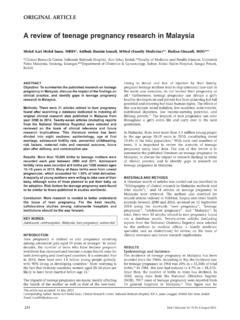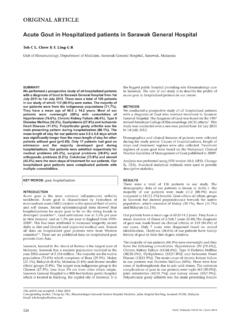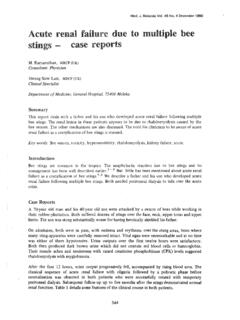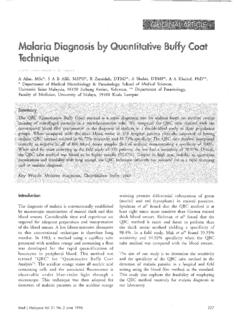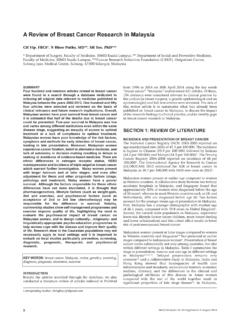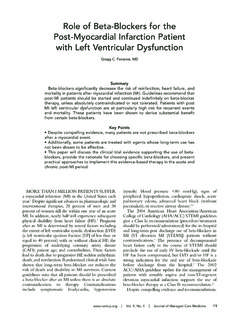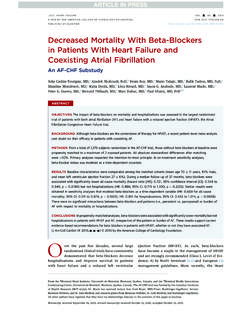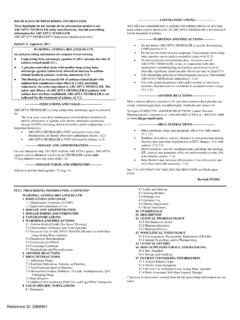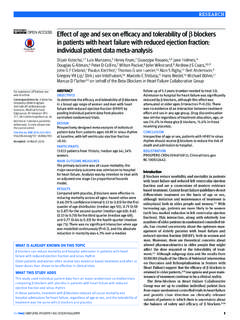Transcription of Utilization of Beta Blockers Post-Myocardial Infarction
1 ORIGINAL ARTICLE. Utilization of Beta Blockers Post-Myocardial Infarction W M Ong, BPharm*, S Che Zuraini, MClin Pharm**, W A Wan Azman, PhD**, R Rajasuriar, PhD*. *Department of Pharmacy, University of Malaya, Malaysia, **University Malaya Medical Centre, Malaysia,**Department of Medicine, University of Malaya, Malaysia SUMMARY. Beta Blockers provide both morbidity and mortality benefits Studies have also shown that although beta Blockers were for Post-Myocardial Infarction (MI) patients. Despite this, given after MI, the prescribed dosages were not at dosages beta Blockers are still often underused or used at that matched those in clinical trials with proven mortality suboptimal dosages. This was a retrospective observational benefits 2,4. Two studies have found that even patients who study with the objectives of estimating the proportion of were 65-75 years benefited from full-dosage of beta post -MI patients who are receiving beta-blocker therapy in blockers14,15.
2 Therefore, not only should these patients receive University Malaya Medical Centre (UMMC), assessing the beta-blocker therapy, their dosages should also be optimized number of them receiving beta Blockers at optimal dosages to equivalent effective dosages used in clinical trials. and determining the factors associated with beta-blocker prescribing post -MI. Several studies have described various factors associated with beta-blocker underuse 8,16,17. These include diabetes mellitus, Of 315 patient case notes reviewed, were prescribed advanced age, calcium channel blocker use and other beta Blockers . However, dosages were optimized in only therapies. Ironically, some of these patient populations have of patients. Reasons for not optimizing the dosages been found to derive greater benefits when prescribed beta were typically not due to the presence of contraindications Blockers than when not.
3 For instance, patients with diabetes to beta Blockers . Elderly (> 65 years old), ejection fraction mellitus, which is an important risk factor for mortality after (EF) < 40%, a history of cerebrovascular accident (CVA) or MI, have significantly lower mortality rates at 1-year when mild asthma, use of calcium channel blocker (CCB), digoxin they received beta-blocker therapy compared to those who or anti-asthmatic agents were all significantly associated did not 11. Similarly, this study also found older patients had with a reduced rate of beta-blocker prescribing post -MI. greater mortality benefits when prescribed beta Blockers post - More effort should be placed in improving its use in specific MI compared to those not receiving the drug. Other reasons patient populations. Initiatives to optimize the dosage of that may contribute to beta-blocker underuse include the beta Blockers to recommended dosages that matched those diagnosis of asthma, symptomatic heart failure, prescribers'.
4 In clinical trials with proven mortality benefits will also need concern of its side effects and women as demonstrated in to be intensified. various studies 8,18. The underuse of beta Blockers among diabetics, asthmatics and patients with heart failure are KEY WORDS: likely due to continuing misconceptions that beta Blockers should be avoided in these groups of patients although many Beta- Blockers ; BB; Post-Myocardial Infarction ; post -MI recent studies have proven otherwise 19,20,21, 22. INTRODUCTION. To our knowledge, there has not been any study published on the use of beta Blockers post -MI in the local setting. Therefore, myocardial Infarction (MI) is a major health problem, with the aim of this study was 1 to assess the Utilization of beta relatively high rates of morbidity and mortality 1. Based on Blockers post -MI in a large tertiary care hospital in Malaysia evidence from numerous large, randomized placebo- and 2 to determine the factors associated with beta-blocker controlled trials, beta Blockers are strongly recommended in prescribing.
5 The findings of this study will be helpful to both all post -MI patients provided that they have no specific clinicians and pharmacists in designing useful interventional contraindications to this drug 2,3. Beta Blockers have been strategies to optimize the standard of care delivered to post - demonstrated to improve the long-term prognosis post -MI in MI patients. terms of mortality and sudden cardiac death 3,4. Additionally, MATERIALS AND METHODS. beta Blockers administered post -MI have been shown to decrease reinfarction rates 4,5 and infarct size 6,7, prevent ischemic complications 3, and reduce the incidence of This was a retrospective observational study conducted in intracerebral hemorrhage 8. University Malaya Medical Centre (UMMC). Despite strong evidence from landmark clinical trials on the The sampling frame included patients admitted to UMMC.
6 Long-term survival benefits of beta-blocker use post -MI, beta with a history of MI diagnosed between 2002 and 2004, Blockers are still underused 4,9,10,11,12. A systematic review with identified from their International Classification of Diseases, meta regression analysis of beta-blockade after MI found that Tenth Revision (ICD-10) codes for the discharge diagnosis of beta Blockers were used in less than half of eligible patients13. MI; , , , , , and The This article was accepted: 23 August 2012. Corresponding Author: Ong Woon May, Pharmaceutical Services Division, Ministry of Health Malaysia, Lot 36, Jalan Universiti, 46350 Petaling Jaya Email: 58 Med J Malaysia Vol 68 No 1 February 2013. Utilization of Beta Blockers Post-Myocardial Infarction review of beta-blocker use post -MI was done after the release bradycardia or systolic hypotension 2. These patients were of the 2001 Malaysian Clinical Practice Guidelines (CPG) on considered to have optimized dosages although their final acute MI (AMI) in mid-2001 to allow a sufficient period for doses had not reached the target effective doses information dissemination and for physicians to adopt to the recommended in landmark clinical trials.
7 New changes in prescribing recommendations since the landmark clinical trials for which we were assessing the The protocol of this study was approved by the UMMC. optimal dosages were adopted by these guidelines. Patients Medical Ethics Committee (Reference number: ). who were diagnosed in the year 2005 were excluded, as a time period of 12-months had been chosen to assess patients Data entry and statistical analyses were done using the for beta-blocker dosage optimization in this study. Statistical Package for the Social Sciences version software (SPSS Inc., Chicago IL, USA). Data were tabulated A total of 1541 registration numbers (RN) were generated and and presented in the graphical form using Microsoft Excel a systematic sampling was conducted with every 4th patient and Word. Descriptive statistics were used to present the chosen as a study sample.
8 The targeted sample size was 385 proportion of patients receiving beta-blocker therapy post - patients. The calculated sample size (confidence level of 95%; MI. The assessment of significant patient characteristics CI of 5%; estimated proportion of ) was 308 patients. associated with the use of beta Blockers was done using Following the identification of 385 RN, the patients' medical bivariate analysis of chi-square ( 2) or Fisher's Exact Test (FET). records were subsequently reviewed to assess their eligibility for discrete variables (age, ejection fraction, comorbidities, in the study. concurrent medications, and revascularization). A p value of < was considered significant in this study. All patients with a history of MI, confirmed by the World RESULTS. Health Organization (WHO) criteria for MI diagnosis and who survived for at least 1 year were included.
9 The confirmation based on the WHO criteria (2 out of 3: ischemic Out of the 385 case notes reviewed, 315 patients met the type chest pain; electrocardiogram (ECG) changes; raised inclusion criteria (Figure 1). Majority of patients were male cardiac markers) 29 was done according to the presenting ( ), Malay ( ) and 65 years old ( ) with a parameters noted in the case notes. The presence of a Q wave mean standard deviation (SD) age of ( ) years old. on ECG tracings was required for patients with the diagnosis of an old MI prior to inclusion in the study. of patients were thrombolysed with streptokinase and revascularization (percutaneous transluminal coronary We excluded patients with first-admission deaths, as these angioplasty) with or without stenting or coronary artery patients did not have the opportunity to receive beta-blocker bypass grafting surgery was performed in 168 ( ).
10 Therapy. Because of the difficulty to obtain complete patients. medication records, patients who were transferred from other institutions were excluded. We also excluded patients with Hypertension ( ) was found to be the commonest incomplete medical records and those who failed to follow up comorbidity among post -MI patients followed by diabetes for a 12-months period in UMMC following MI because of the ( ). Aspirin (94%) was the most frequently used need to assess beta-blocker dosage optimization. concurrent medication followed by statins ( ). Patients' medical records that fulfilled the inclusion and Treatment with Beta Blockers Post-Myocardial Infarction exclusion criteria were reviewed for a period of 12 months Two hundred and fifty three ( ) patients received oral following the diagnosis of MI. beta-blocker therapy. However, 9 ( ) of them stopped therapy within 6-months due to contraindications.
